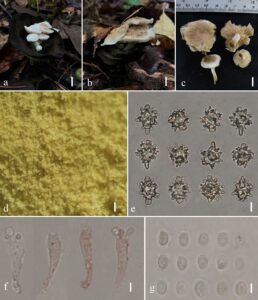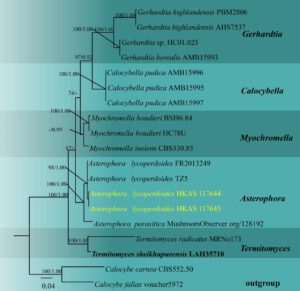Asterophora lycoperdoides (Bull.) Ditmar, Neues Journal Botanik 3(3, 4), 56 (1809)
Index Fungorum number: IF 233153; Facesoffungi number: FoF 14370; Fig. 1
Pileus 2–4 cm diam., hemispherical to convex or plane, white (1A1), powdery, slightly depressed to the depressed shape of center, reflexed aspects of margin. Chlamydospores pile on the pileus, light yellow (1A5); context 1–2 mm diam., white (1A1) to pale white (1A2). Lamellae white (1A1) when young, becoming yellowish white (1A2) to pale yellow (1A3), lamella edge eroded, lamellulae in 2–3 tiers, 2–3 mm wide. Stipe 1.1–2.0 × 0.3–0.4 cm, cylindrical, solid, fiber. Odor and taste not distinctive.
Basidiospores [50/2/2] 4.2–5.2 × 2.9–3.8 μm, av. 4.6 × 3.3 μm, Q=1.1–1.6, Qav=1.4, ovoid to ellipsoid, sparse, thin-walled, smooth under light microscope. Basidia 22–24 × 5–7 μm, av. 23.5–6.2 μm, sparse, broadly clavate, 4-spored. Chlamydospores 18.8–24.7 × 12.1–19.9 μm, av. 20.9–15.0 μm, numerous on the pileus surface, subcylindrical, echinulate. Cystidia not seen.
Material examined – Thailand. Chiang Mai Province, Pha Deng Village, Pa Pae Sub District, 14 July 2020, S.M. Tang 2020071470 (HKAS 117644); ibid., Pa Pae Sub District, S.M. Tang 2020071429 (HKAS 117645).
GenBank accession numbers – HKAS 117644 – ITS: MZ914396, LSU: MZ914399; HKAS 117645 – ITS: MZ914397, LSU: MZ914400.
Known distribution (based on molecular data) – China (Wang et al. 2004), India (Sharma et al. 2007), Turkish (Uzun et al. 2010), Thailand (this study).
Known hosts (based on molecular data) – Russula nigricans (Homma et al. 2006).
Notes – Asterophora lycoperdoides is recognized by its white pileus, chlamydospores formed on the pileus and echinulate. Asterophora has four species, A. salvaterrensis, A. lycoperdoides, A. mirabilis and A. parasitica. However, A. salvaterrensis has zonate, greenish brown to brownish pileus and smooth chlamydospores (Blanco-Dios 2011). Asterophora mirabilis has a smooth pileus, and chlamydospores formed in the lamellar trama and pileal trama above the lamellae (Blanco-Dios 2011). Asterophora parasitica has relatively larger basidiospores (5–6 × 3–4 μm) and smooth chlamydospores (Blanco-Dios 2011).

Fig. 1 – Asterophora lycoperdoides (HKAS 117644 & HKAS 117645, additional collections). a–c Basidiomata (a HKAS 117644, b–c HKAS 117645). d Chlamydospores on the surface of pileus. e Chlamydospores. f Basidia. g Basidiospores. Scale bars: a–c = 1 cm, d = 100 μm, e = 10 μm, f, g = 5 μm.

Fig. 2 – Phylogram generated from maximum likelihood analysis based on combined ITS and LSU sequence data of taxa in Lyophyllaceae. Seventeen strains are included in the combined analyses which comprised 1576 characters (691 characters for ITS, 885 characters for LSU) after alignment. Tree topology of the maximum likelihood analysis is similar to the Bayesian analysis. The best RaxML tree with a final likelihood value of -6583.545571. The matrix had 418 distinct alignment patterns, with 30.40% of undetermined characters or gaps. Evolutionary models applied for ITS and LSU genes are HKY+G and GTR+I models, respectively. Bootstrap support values for ML and MP equal to or greater than 70% and Bayesian posterior probabilities equal to or greater than 0.90 are indicated near the branches. The tree is rooted with Calocybe carnea (CBS 552.50) and C. fallax (voucher 5972). Ex-type strains are in bold. The newly generated sequences are indicated in yellow.
